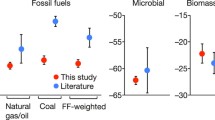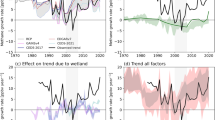Abstract
The sources of methane are the most complex and critical element in understanding the concentrations of atmospheric methane and their trends. For those who want to reduce methane in the atmosphere or prevent it from increasing, controlling the sources is perhaps the only practical approach. Accordingly, a significant portion of this book is devoted to estimating the global and regional emission rates. The purpose of this chapter is to introduce the subsequent chapters on individual sources and to lay the foundation for the common elements of determining global emission rates from the many and varied sources of methane.
Access this chapter
Tax calculation will be finalised at checkout
Purchases are for personal use only
Preview
Unable to display preview. Download preview PDF.
Similar content being viewed by others
References
Aselmann, I., and P.J. Crutzen. 1989. Global distribution of natural freshwater wetlands and rice paddies, their net primary productivity, seasonality and possible methane emissions. J. Atmos. Chem.,8:307-358.
Bartlett, K., and R.C. Harriss. 1993. Review and assessment of methane emissions from wetlands. Chemosphere, 26: 261 - 320.
Bates, T.S., K.C. Kelly, J.E. Johnson, and R.H. Gammon. 1996. A reevaluation of the open ocean source of methane to the atmosphere. J. Geophys. Res. 101 (D3): 6953 - 6961.
Blunier, T., J.A. Chappellaz, J. Schwander, J.-M. Barnola, T. Desperts, B. Stauffer, and D. Raynaud. 1993. Geophys. Res. Lett. 20 (20): 2219 - 2222.
Butler, J.H., J.W. Elkins, T.M. Thompson, B.D. Hall, T.H. Swanson, and V. Koropolov. 1991. Oceanic consumption of CH,CCI3: implications for tropospheric OH. J. Geophys. Res., 96:22, 347 - 22, 355.
Chappellaz, J., J.M. Barnola, D. Raynaud, Y.S. Korotkevich, and C. Lorius. 1990. Nature, 345: 127 - 131.
Chappellaz, J.A, I.Y. Fung, and A.M. Thompson. 1993. The atmospheric CH, increase since the Last Glacial Maximum, 1. Source estimates. Tellus,in press.
Cofer, W.R. III, J.S. Levine, E.L. Winstead, and B.J. Stocks. 1991. Trace gas and particulate emissions from biomass burning in temperate ecosystems. In: Global Biomass Burning, Atmospheric, Climatic, and Biospheric Implications (J.S. Levine, ed.):203-208.
Etheridge, D.M., G.I. Pearman, and P.J. Fraser. 1992. Changes in tropospheric methane between 1841 and 1978 from a high accumulation Antarctic ice core. Tellus 44B: 282 - 294.
Fan, S.M., S.C. Wofsy, P.S. Bakwin, D.J. Jacob, S.M. Anderson, P.L. Kebarian, J.B. McManus, C.E. Kolb, and D.R. Fitzjarrald. 1992. Micrometeorological measurements of CH, and CO, exchange between the atmosphere and subarctic tundra. J. Geophys. Res. 97(D15): 16,627-16, 643.
Fung, I., J. John, J. Lerner, E. Matthews, M. Prather, L.P. Steele, and P.J. Fraser. 1991. Three-dimensional model synthesis of the global methane cycle. J. Geophys. Res., 96 (D7):13, 033 - 13, 065.
Harriss, R.C., D.I. Sebacher, and F.P. Day, Jr. 1982. Methane flux in the Great Dismal Swamp. Nature, 297: 673 - 674.
Ito, S., E.W.F. Peterson, and W.R. Grant. 1989. Rice in Asia: is it becoming an inferior good? Amer. J. Agr. Econ., 71: 32 - 42.
Kammen, D.M., and B.D. Marino. 1993. On the origin and magnitude of pre-industrial anthropogenic CO, and CH, emissions. Chemosphere, 26: 69 - 86.
Khalil, M.A.K. 1992. A statistical method for estimating uncertainties in the total global budget of trace gases. J. Environ. Sci. Health, A27 (3): 755 - 770.
Khalil, M.A.K., and R.A. Rasmussen. 1983. Sources, sinks, and seasonal cycles of atmospheric methane. J. Geophys. Res., 88:5, 131-5, 144.
Khalil, M.A.K., and R.A. Rasmussen. 1984. The atmospheric lifetime of methylchloroform (CH,CCI3). Tellus, 36B:317-312.
Khalil, M.A.K., and R.A. Rasmussen. 1985. Causes of increasing atmospheric methane: depletion of hydroxyl radicals and the rise of emissions. Atmos. Environ., 19: 397 - 407.
Khalil, M.A.K., and R.A. Rasmussen. 1987. Atmospheric methane: trends over the last 10,000 years. Atmos. Environ., 21:2, 445 - 2, 452.
Khalil, M.A.K., and R.A. Rasmussen. 1990a. Atmospheric methane: recent global trends. Environ. Sci. Tech., 24: 549 - 553.
Khalil, M.A.K., and R.A. Rasmussen. 1990b. Constraints on the global sources of methane and an analysis of recent budgets. Tellus, 42B: 229 - 236.
Khalil, M.A.K., and R.A. Rasmussen. 1993. Decreasing trend of methane: unpredictability of future concentrations. Chemosphere, 26 (1-4): 803 - 814.
Khalil, M.A.K., M.J. Shearer, and R.A.Rasmussen. 1996. Atmospheric methane over the last century. World Resource Review 8: 481 - 492.
Krol, M., P.J. van Leeuwen, and J. Lelieveld. 1998. Global OH trend inferred from methylchloroform measurements. J. Geophys. Res. 103(D9): 10,697-10, 711.
Lacroix, A.V. 1993. Unaccounted-for sources of fossil and isotopically-enriched methane and their contribution to the emissions inventory: a review and synthesis. Chemosphere, 26 (1-4): 507 - 557.
Lambert, G., and S. Schmidt. 1993. Reevaluation of the oceanic flux of methane: Uncertainties and long term variations. Chemosphere 26: 579 - 589.
Lassey, K.R., D.C. Lowe, C.A.M. Brenninkmeijer, and A.J. Gomez. 1993. Atmospheric methane and its carbon isotopes in the southern hemisphere: their time series and an instructive model. Chemosphere, 26 (1-4): 95 - 109.
Lerner, J., E. Matthews, and I. Fung. 1988. Methane emission from animals: a global high-resolution data base. Global Biogeochem. Cycles, 2:139-156.
Levin, I., P. Bergamaschi, H. Don, and D. Trapp. 1993. Stable isotopic signature of methane from major sources in Germany. Chemosphere, 26 (1-4):161-178.
Levine, J.S., C.P. Rinsland, and G.M. Tennille. 1985. The photochemistry of methane and carbon monoxide in the troposphere in 1950 and 1985. Nature, 318: 254 - 257.
Lovelock, J.E. 1977. Methyl chloroform in the troposphere as an indicator of OH radical abundance. Nature, 267: 32 - 33.
Lowe, D.C., C.A.M. Brenninkmeijer, G.W. Brailsford, K.R. Lassey, and A.J. Gomez. 1994. Concentration and 3C records of atmospheric methane in New Zealand and Antarctica: Evidence for changes in methane sources. J. Geophys. Res. 99(D8): 16,913-16, 925.
Lu, Y., and M.A.K. Khalil. 1991. Tropospheric OH: model calculations of spatial, temporal, and secular variations. Chemosphere, 23 (3): 397 - 444.
Marland, G., R.M. Rotty, and N.L. Treat. 1985. CO2 from fossil fuel burning: global distribution of emissions. Tellus, 37B: 243 - 258.
Matthews, E., I. Fung, and J. Lerner. 1991. Methane emission from rice cultivation: geographic and seasonal distribution of cultivated areas and emissions. Global Biogeochemical Cycles, 5 (1): 3 - 24.
Midgley, P.M. 1989. The production and release to the atmosphere of 1,1,1-trichloroethane (methyl chloroform). Atmos. Environ., 23:2, 663 - 2, 665.
Midgley, P.M., and A. McCulloch. 1995. The Production and global distribution of emissions to the atmosphere of 1,1,1-trichloroethane (Methyl chloroform). Atmos. Environ. 29 (14): 1601 - 1608.
Mitchell, B.R. 1980. European Historical Statistics, 2nd Rev. Ed. Facts on File, New York, U.S.A.
Mitchell, B.R. 1982. International Historical Statistics, Africa and Asia. New York University Press.
Mitchell, B.R. 1983. International Historical Statistics, The Americas and Australasia. Gale Research Co., Detroit, Michigan.
Moncrieff, J.B., I.J. Beverland, D.H. Ó Néill, and F.D. Cropley. 1998. Controls on trace gas exchange observed by a conditional sampling method. Atmos. Environ. 32: 3265 - 3274.
Mroz, E.J. 1993. Deuteromethanes: potential fingerprints of the sources of atmospheric methane. Chemosphere, 26 (1-4): 45 - 53.
Pinto, J., and M.A.K. Khalil. 1991. The stability of tropospheric OH during ice ages, interglacial epochs and modern times. Tellus, 43B: 347 - 352.
Prinn, R.G., D. Cunnold, R.A. Rasmussen, P. Simmonds, F. Alyea, A. Crawford, P. Fraser, and R. Rosen. 1987. Atmospheric trends in methylchloroform and the global average for the hydroxyl radical. Science, 238: 945 - 950.
Rasmussen, R.A., and M.A.K. Khalil. 1981. Interlaboratory comparison of fluorocarbons 11, 12, methylchloroform, and nitrous oxide measurements. Atmos. Environ., 15:1,559-1,568. Seiler, W., A. Holzapfel-Pschorn, R. Conrad, and D. Scharffe. 1984. Methane emission from rice paddies. J. Atmos. Chem., 1: 241 - 268.
Simpson, I.J., G.W. Thurtell, G.E. Kidd, M. Lin, T.H. Demetriades-Shah, I.D. Flitcroft, E.T. Kanemasu, D. Nie, K.F. Bronson, and H.U. Neue. 1995. Tunable diode laser measurements of methane fluxes from an irrigated rice paddy field in the Philippines. J. Geophys. Res. 100 (D4): 7283 - 7290.
Singh, H.B. 1977. Preliminary estimation of average tropospheric HO concentrations in the northern and southern hemispheres. Geophys. Res. Let., 4: 453 - 456.
Steele, L.P., E.J. Dlugokencky, P.M. Lang, P.P. Tans, R.C. Martin, and K.A. Masarie. 1992. Slowing down of the global accumulation of atmospheric methane during the 1980s. Nature, 358: 313 - 316.
Stocks, B.J. 1991. The extent and impact of forest fires in northern circumpolar countries. In: Global Biomass Burning, Atmospheric, Climatic, and Biospheric Implications, J.S. Levine, ed.:197-202.
Taylor, J.A., and P.R. Zimmerman. 1991. Modeling trace gas emissions from biomass burning. In: Global Biomass Burning, Atmospheric, Climatic, and Biospheric Implications ( J.S. Levine, ed. ), 345 - 350.
Thompson, A.M., and R.J. Cicerone. 1986. Possible perturbations to atmospheric CO, CH„ and OH. J. Geophys. Res., 91:10, 853-10, 864.
United Nations. 1977, 1978, 1980, 1982, 1984, 1986, 1989, 1990, 1991, 1992, 1994, 1996. FAO Production Yearbook, vols. 30, 31, 33, 35, 37, 39, 42, 43, 44, 45, 47, 49. Food and Agriculture Organization of the United Nations, Rome.
Vaghjiani, G.L., and A.R. Ravishankara. 1991. New measurement of the rate coefficient for the reaction of OH with methane. Nature, 350: 406 - 408.
Wahlen, M., N. Tanaka, R. Henry, B. Deck, J. Zeglen, J.S. Vogel, J. Southon, A. Shemesh, R. Fairbanks, and W. Broecker. 1989. Carbon-14 in methane sources and in atmospheric methane: the contribution from fossil carbon. Science, 245: 286 - 245.
Whalen, S.C., and W.S. Reeburgh. 1992. Interannual variations in tundra methane emission: a 4-year time series at fixed sites. Global Biogeochem. Cycles, 6:139-159.
Author information
Authors and Affiliations
Editor information
Editors and Affiliations
Rights and permissions
Copyright information
© 2000 Springer-Verlag Berlin Heidelberg
About this chapter
Cite this chapter
Khalil, M.A.K., Shearer, M.J. (2000). Sources of Methane: An Overview. In: Khalil, M.A.K. (eds) Atmospheric Methane. Springer, Berlin, Heidelberg. https://doi.org/10.1007/978-3-662-04145-1_7
Download citation
DOI: https://doi.org/10.1007/978-3-662-04145-1_7
Publisher Name: Springer, Berlin, Heidelberg
Print ISBN: 978-3-642-08451-5
Online ISBN: 978-3-662-04145-1
eBook Packages: Springer Book Archive




